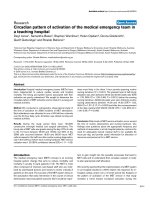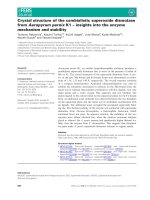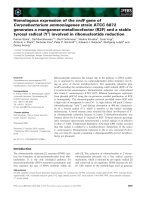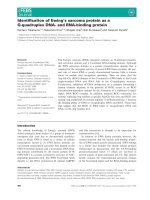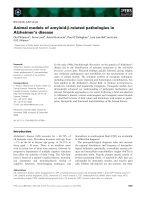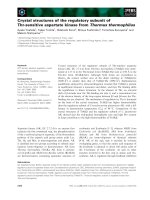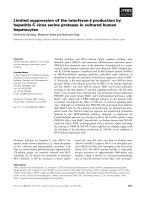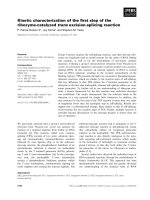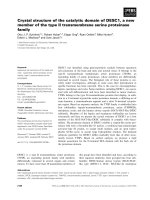Báo cáo khoa học: "Circadian pattern of activation of the medical emergency team in a teaching hospita"
Bạn đang xem bản rút gọn của tài liệu. Xem và tải ngay bản đầy đủ của tài liệu tại đây (392.82 KB, 4 trang )
Open Access
Available online />R303
Vol 9 No 4
Research
Circadian pattern of activation of the medical emergency team in
a teaching hospital
Daryl Jones
1
, Samantha Bates
2
, Stephen Warrillow
3
, Helen Opdam
3
, Donna Goldsmith
2
,
Geoff Gutteridge
2
and Rinaldo Bellomo
3
1
Intensive Care Registrar. Department of Intensive Care and Department of Surgery (Melbourne University), Austin Hospital, Melbourne, Australia
2
Research Nurse. Department of Intensive Care and Department of Surgery (Melbourne University), Austin Hospital, Melbourne, Australia
3
Intensive Care Consultant. Department of Intensive Care and Department of Surgery (Melbourne University), Austin Hospital, Melbourne, Australia
Corresponding author: Rinaldo Bellomo,
Received: 11 Feb 2005 Revisions requested: 16 Mar 2005 Revisions received: 28 Mar 2005 Accepted: 8 Apr 2005 Published: 28 Apr 2005
Critical Care 2005, 9:R303-R306 (DOI 10.1186/cc3537)
This article is online at: />© 2005 Jones et al.; licensee BioMed Central Ltd.
This is an Open Access article distributed under the terms of the Creative Commons Attribution License ( />2.0), which permits unrestricted use, distribution, and reproduction in any medium, provided the original work is properly cited.
Abstract
Introduction Hospital medical emergency teams (METs) have
been implemented to reduce cardiac arrests and hospital
mortality. The timing and system factors associated with their
activation are poorly understood. We sought to determine the
circadian pattern of MET activation and to relate it to nursing and
medical activities.
Method We conducted a retrospective observational study of
the time of activation for 2568 incidents of MET attendance.
Each attendance was allocated to one of 48 half-hour intervals
over the 24-hour daily cycle. Activation was related nursing and
medical activities.
Results During the study period there were 120,000
consecutive overnight medical and surgical admissions. The
hourly rate of MET calls was greater during the day (47% of calls
in the 10 hours between 08:00 and 18:00), but 53% of the
2568 calls occurred between 18:00 and 08:00 hours. MET
calls increased in the half-hour after routine nursing observation,
and in the half-hour before each nursing handover. MET service
utilization was 1.25 (95% confidence interval [CI] = 1.11–1.52)
times more likely in the three 1-hour periods spanning routine
nursing handover (P = 0.001). The greatest level of half-hourly
utilization was seen between 20:00 and 20:30 (odds ratio [OR]
= 1.76, 95% CI = 1.25–2.48; P = 0.001), before the evening
nursing handover. Additional peaks were seen following routine
nursing observations between 14:00 and 14:30 (OR = 1.53,
95% CI = 1.07–2.17; P = 0.022) and after the commencement
of the daily medical shift (09:00–09:30; OR = 1.43, 95% CI =
1.00–2.04; P = 0.049).
Conclusion Peak levels of MET service activation occur around
the time of routine observations and nursing handover. Our
findings raise questions about the appropriate frequency and
methods of observation in at-risk hospital patients, reinforce the
need for adequately trained medical staff to be available 24
hours per day, and provide useful information for allocation of
resources and personnel for a MET service.
Introduction
The medical emergency team (MET) concept is an evolving
hospital system change that aims to reduce morbidity and
mortality in acutely ill ward patients [1-3]. The MET is most
often comprised of intensive care-based staff who are mobi-
lized by ward-based doctors and nurses to review critically ill
patients on the ward. The success of the MET system relies on
the assumption that early intervention in the course of clinical
deterioration improves patient outcome [4]. It would be impor-
tant to gain insight into the possible processes that lead to
MET calls and to understand their circadian variation in order
to plan appropriate staff allocation.
We recently reported that the implementation of a MET system
in our hospital resulted in a 65% relative risk reduction for in-
hospital cardiac arrest over a 4-month period [4]. Analysis of
the pattern of activation of the MET service in that study
revealed a trend toward increased activation during the
CI = confidence interval; MET = medical emergency team; OR = odds ratio.
Critical Care Vol 9 No 4 Jones et al.
R304
evening (P = 0.12). Lee and coworkers [5] reported that 36%
of 522 MET calls registered over a 1-year period occurred
between the hours 20:00 and 08:00. No information, however,
exists on the possible relationship between routine nursing or
medical activity and MET calls.
Available evidence suggests that between 69% and 82% of
MET calls are initiated by a nurse [5,6]. The criteria for MET
activation at our institution are based on derangements in vital
signs that are typically measured or assessed at times of rou-
tine nursing observation and handover. Thus, we hypothesized
that activation of the MET service at our institution would clus-
ter around these times. To test this hypothesis we analyzed the
frequency of MET activation at half-hourly intervals over a 24-
hour period and related this to aspects of nursing and medical
daily routine.
Materials and methods
The hospital
Austin Health is a university-affiliated teaching hospital with
three hospital campuses situated in Melbourne, Australia. The
Austin Hospital is the acute care hospital in which the MET
service operates. It has 400 beds and receives approximately
60,000 day and overnight admissions per year.
Hospital emergency response teams
The acute care hospital has two levels of medical emergency
responses and teams. A traditional cardiac arrest ('code blue')
team is comprised of a cardiology fellow and coronary care
nurse, as well as an intensive care fellow and nurse, and the
receiving medical unit fellow. All wards are equipped with
resuscitation trolleys containing resuscitation drugs and
defibrillators.
In September 2000 a MET system was introduced into the
acute campus following an extensive preparation and educa-
tion process [4]. The team consists of an intensive care fellow
and nurse, as well as the receiving medical unit fellow. It can
be activated by any member of the hospital staff according to
preset criteria for physiological instability. All code blue and
MET calls are communicated by the switchboard operators
through the hospital loudspeakers and paging system, and a
detailed log of all calls is maintained.
Criteria for medical emergency team activation
Calling criteria for our MET service are based on acute
changes in heart rate (<40 or >130 beats/min), systolic blood
pressure (<90 mmHg), respiratory rate (<8 or >30 breaths/
min), conscious state, urine output (<50 ml over 4 hours), and
oxygen saturation derived from pulse oximetry (<90%, despite
oxygen administration). In addition, the calling criteria contain
a 'staff member is worried' category to allow staff to summon
senior assistance to manage any possible emergency
situation.
Outcome measures
Information on the activation of all MET calls is maintained on
a hospital switchboard logbook that includes the date and
time of the call, as well as the ward where the MET review
occurred. The details of 2568 MET calls were manually
entered into an MS Excel™ spreadsheet by two investigators
who worked together and cross-checked the entries to mini-
mize errors.
Each call was allocated to one of 48 half-hourly intervals over
a 24-hour period (24:00–00:30, 00:31–01:00, 01:01–01:30,
01:31–02:00, etc.). A graph was then constructed from the
2568 episodes of MET service review to illustrate the fre-
quency of activation at various times over the 24-hour period.
Episodes of activation were related to the periods of routine
nursing handover (07:00, 13:00 and 21:00), routine nursing
observations (02:00, 06:00, 10:00, 14:00, 18:00 and 22:00),
and commencement and completion of the daily medical shift
(08:00–18:00).
Statistical analysis
The frequency of MET service activation during peak periods
was compared with the average activation over the 24-hour
period. In the case of nursing handover, the 1-hour period
spanning handover (the half-hour before and the half-hour
after, repeated three times per day for a total of 3 hours) was
compared with the average activation over the 24-hour period.
Statistical significance was determined by analysis with
Fisher's exact test using MS Windows Statview (Abacus Con-
cepts, Berkeley, CA, USA). P < 0.05 was considered statisti-
cally significant.
Results
During the study period (August 2000 to September 2004)
there were 120,000 consecutive overnight medical and surgi-
cal admissions to the Austin Hospital and 2568 activations of
the MET service. Activation of the MET service was not uni-
form over the 24-hour period (Fig. 1).
Over the study period, 53% of the 2568 calls occurred in the
14 hours between 18:00 and 08:00 (58% of the day). On an
hourly basis, MET call utilization was more common during the
hours covered by the parent unit doctors (47% of MET calls
during 42% of the day). In the 5 years that the MET system has
operated, there has been a trend for an increasing proportion
of calls to occur after hours (18:00–08:00; Fig. 2). Thus, in
2004, 374 out of 669 (55.9%) MET calls occurred after hours,
compared with 69 out of 139 (49.6%) during the year 2000
(odds ratio [OR] = 1.13, 95% CI = 0.82–1.54; P = 0.19).
On average there were 106 calls (2568/24) for each hour
period, or 53 calls (2568/48) per half-hour period. Increased
activity of the MET service was typically seen in the half-hour
following routine observations, and in the half-hour before
Available online />R305
routine nursing handover (Fig. 1). A total of 401 calls were
made in the three 1-hour periods spanning nursing handover.
During these periods, activation of the MET service was 1.25
times more likely (95% CI = 1.11–1.52) when compared with
the average activation over the 24-hour period (P = 0.001).
The highest level of MET service activation for any given half-
hour period was seen between 20:00 and 20:30, when use of
the MET service was 1.8 (95% CI = 1.25–2.48) times greater
than average half-hourly utilization (P = 0.001). Additional
peaks of activity were seen between 14:00 and 14:30 (OR =
1.53, 95% CI = 1.07–2.17; P = 0.022) and between 09:00
and 09:30 (OR = 1.43, 95% CI = 1.00–2.04; P = 0.049). All
other peaks of activity failed to achieve statistical significance.
Discussion
We report, for the first time, a detailed analysis of the level of
utilization of a MET service over a 24-hour period and found a
significant increase in the number of MET calls around periods
of nursing handover and routine nursing observation. In addi-
tion, although MET calls occurred more frequently during the
hours 08:00–18:00 (47% of calls during 42% of the day), a
substantial proportion of MET calls occur after normal working
hours (53% of calls during 58% of the day), with the peak time
of activity occurring between 20:00 and 20:30. These findings
have important implications for the frequency and method of
patient monitoring, as well as for allocation of critical care
resources and MET personnel, and require detailed
discussion.
In a previous study at our institution [6] there was a trend
toward more frequent activation of the MET service in the
evening. In a study of 522 MET calls over a 1-year period, Lee
and coworkers [5] demonstrated that 36% of MET calls were
registered during the nightshift (20:00–8:00). Although the
rate of MET calls did not vary during periods of reduced staff-
ing, the investigators emphasized the importance of providing
appropriately trained medical staff on a 24-hour basis.
In the present study, 53% of all calls occurred 'out of hours'
(18:00–08:00) when wards are not staffed by parent unit doc-
tors. In addition, there was a trend toward increased frequency
of activation of the MET service during these hours in the 5
years following the introduction of the MET system. When
directly compared with the study conducted by Lee and cow-
orkers [5], 46.2% of the 2568 MET calls registered in the
present study occurred between 20:00 and 08:00 hours. Our
findings suggest a greater utilization of the MET service in the
hours not covered by the parent unit medical staff than has
previously been reported.
The frequent use of the MET service after 18:00 has important
implications for allocation of resources to the MET service out
of hours, and further reinforces previously reported opinion [5]
that appropriately trained medical staff should be available on
a 24-hour basis to assess and treat acutely ill hospital patients.
Utilization of a MET system has been associated with a reduc-
tion in all-cause hospital mortality in our institution [4,6]. Thus,
our observation that MET service activation clusters around
times of nursing handover and routine nursing observations
raises questions about the appropriate frequency and meth-
ods of observations in 'at-risk' hospital patients. A more fre-
quent or automated (e.g. telemetry) observation system for
such at-risk patients may result in further reductions in mortal-
ity and morbidity. It is unlikely that patients would develop
acute illness more frequently at specific times that happen to
coincide with nursing observations or handover. It is more
likely that the patient was discovered to be unwell only during
a 'scheduled visit' by his/her care givers. In the case of medical
staff, this would correspond to the morning medical ward
round. In the case of nursing staff, we have clearly demon-
Figure 1
Medical emergency team (MET) calls over 24 hoursMedical emergency team (MET) calls over 24 hours. Shown is a graph
illustrating the number of MET calls made per half-hour over a 24-hour
period for 2568 episodes of MET review in relation to aspects of daily
nursing and medical routine. Arrows demonstrate periods of nursing
handover (red, up-pointing arrows), the beginning and end of the daily
medical shift (green, down-pointing arrows), and periods of routine
nursing observations (pink, shorter, up-pointing arrows). The dotted line
represents the average number of MET calls made per half-hour inter-
val. *P < 0.05.
Figure 2
Medical emergency team (MET) calls during periods 08:00–18:00 and 18:00–08:00 comparisonMedical emergency team (MET) calls during periods 08:00–18:00 and
18:00–08:00 comparison. Shown is a comparison of the percentage of
MET calls made during the periods 08:00–18:00 and 18:00–08:00 for
the years 2000–2004.
Critical Care Vol 9 No 4 Jones et al.
R306
strated increased levels of MET activity during periods when
nurses are more likely to be tending to the patient. It is likely,
therefore, that a substantial proportion of these patients would
have been ill for some time before the call was made, and were
only identified during routine observations or at the time of
nursing handover. It is also possible that the diurnal variation
of identifying 'patients in crisis' observed in the present study
would not be seen in an environment with more automated
and/or continuous monitoring.
The present study has a number of limitations. First, it is an
observational study and does not demonstrate the effect of
MET service utilization on patient outcome. However, we know
from previous studies [4,6] that the introduction of the MET
service was associated with significant beneficial effects on
morbidity and mortality. Second, the pattern of fluctuation of
the MET service at our institution is likely to be based on the
calling criteria that we have implemented. The study may not
apply to other hospitals where alternative calling criteria are
employed. However, we deliberately employed simple calling
criteria to increase the ease of utilisation of the MET system at
our institution. Furthermore, the timing and frequency of
patient observations reported in the study would be typical of
most hospitals. Finally, information on episodes of MET review
was obtained from the hospital switchboard log and did not
provide information on the member of staff who activated the
system. It would be interesting to known whether there was
variation in the nature of the member (doctor versus nurse) and
seniority of staff at various times of the day. We are currently
collecting information on this aspect of MET operation.
Conclusion
In our institution, peak levels of MET service utilization occur
around the time of routine nursing observations and nursing
handover, and the majority of calls occur after hours. Our find-
ings raise questions about the appropriate frequency and
technology of observations in hospital ward patients. They also
provide useful information to guide appropriate resource allo-
cation for the provision of the MET service.
Competing interests
The author(s) declare that they have no competing interests.
Authors' contributions
DJ conceived the study, constructed the data base, and was
the principle author of the manuscript. SB, DG, and SW
assisted with construction of the data base. HO, GG, and RB
contributed with the study design and authorship of the man-
uscript. All authors read and approved the final manuscript.
References
1. Buist MD, Jarmolowski E, Burton PR, Bernard SA, Waxman BP,
Anderson J: Recognising clinical instability in hospital patients
before cardiac arrests or unplanned admissions to intensive
care. Med J Aust 1999, 171:22-25.
2. Franklin C, Mathew J: Developing strategies to prevent in-hos-
pital cardiac arrest: analyzing responses of physicians and
nurses in the hours before the event. Crit Care Med 1994,
22:244-247.
3. Schein RM, Hazday N, Pena M, Ruben BH, Sprung CL: Clinical
antecedents to in-hospital cardiopulmonary arrests. Chest
1990, 98:1388-1392.
4. Bellomo R, Goldsmith D, Uchino S, Buckmaster J, Hart GK,
Opdam H, Silvester W, Doolan L, Gutteridge G: A prospective
before-and-after trial of a medical emergency team. Med J
Aust 2003, 179:283-287.
5. Lee A, Bishop G, Hillman KM, Daffurn K: The medical emergency
team. Anaesth Intensive Care 1995, 23:183-186.
6. Bellomo R, Goldsmith D, Uchino S, Buckmaster J, Hart G, Opdam
H, Silvester W, Doolan L, Gutteridge G: Prospective controlled
trial of effect of medical emergency team postoperative mor-
bidity and mortality rates. Crit Care Med 2004, 32:916-921.
Key messages
• More than half of MET calls occur after hours.
• The peak time of MET activation is at 20:00, just before
nursing handover.
• Other peak activities occur around nursing handover
times or medical ward round times.
• These findings suggest that critical illness detection in
hospital is episodic.
• More systematic approaches to hospital patient moni-
toring may be desirable in order to provide more timely
intervention.
